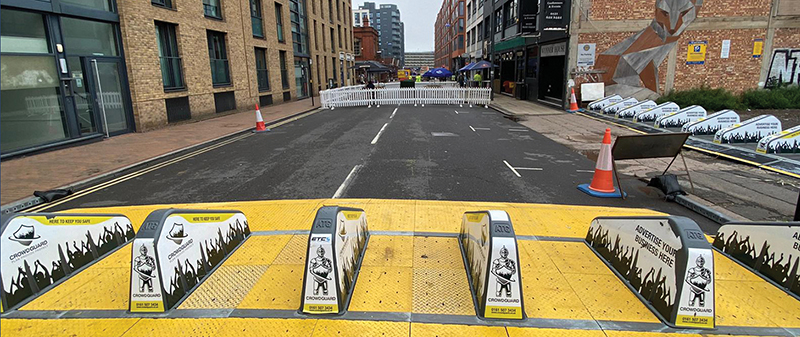 With vehicular threats becoming increasingly sophisticated, Hostile Vehicle Mitigation (HVM) has a vital role in defending the public and property, but is it something that any installer can take on?
With vehicular threats becoming increasingly sophisticated, Hostile Vehicle Mitigation (HVM) has a vital role in defending the public and property, but is it something that any installer can take on?
It is no surprise that political targets and emotive businesses such as animal testing laboratories need to maximise their security measures. Those companies and organisations have a duty of care towards their staff and visitors, but what about general public areas? The bombing of Manchester Arena in 2017 has led to the Draft Bill known as Martyn’s Law, which will apply to anyone responsible for publicly accessible locations used for everyday activities such as entertainment, leisure, retail, sports etc to consider the threat from terrorism and to implement appropriate and proportionate measures. Once this is introduced establishments of all types will need to review protection and safety solutions across the board, so it’s not just the traditional target organisations that need to be concerned about terror attacks.
Hostile Vehicle Mitigation (HVM) is a critical aspect of protecting the public and property, and its correct implementation is paramount. Recognising this, the Perimeter Security Suppliers Association (PSSA) is set to introduce the Hostile Vehicle Mitigation Installers Scheme (HVMIS) as a code of conduct requirement of PSSA membership. The Scheme aims to set the requirements and processes to ensure quality and efficiency in HVM installation and maintenance. According to PSSA Chairman Paul Jeffery, the development of the HVMIS was no small feat. It involved an elaborate process of creation, evaluation, and trial that included participation from Government bodies, PSSA Council, and several installers.
“Although the initial intention was to present HVMIS as a government-supported scheme, the complexities surrounding potential future legislation led to a decision for PSSA to act unilaterally. The idea was to mandate the scheme for PSSA members, ensuring a unified standard across the industry.”
The process saw several rounds of checks and re-checks, to validate the approach and make necessary refinements. The scheme was finalised and, with the Council’s approval, is expected to be implemented by the end of 2023.
As Paul explains: “I think it’s absolutely necessary to make sure that people are fitting measures properly and that they are communicating properly with their customers. I have seen so many systems incorrectly installed that I think the sooner we can get the code of conduct out there the better.”
PSI caught up with Paul to find out more about HVM and the important role that installers have in ensuring safety for customers and the public.
HVM is much more than bollards isn’t it?
Yes, the term “hostile vehicle mitigation” can be applied to any measure that will limit the effect of a vehicle (both hostile and accidental) from damaging property or people. For example, we have been pushing for a long time to try to get HVM designed-in at the front end of buildings, such as with the raising of access points with steps so that people can’t just drive straight into a property. There’s much more to effective HVM than putting bollards around the premises.
Should HVM measures be obvious to the public?
There are two schools of thought concerning this. Obviously if people know that it’s HVM, then they are less likely to attack it, but if they don’t recognise the measure this could lead to there being an increased risk of attack albeit defended. As with any form of security it is a deterrent, and it doesn’t necessarily remove the threat completely it just moves it on to somewhere else – an easier target.
What are the typical HVM applications?
Certainly, Embassies are well protected because there is always somebody with a personal or political grudge, similarly government buildings such as the Houses of Parliament or Downing Street have got plenty of protection in place. You might think that military bases would have lots of HVM in place, but they are mostly happy to rely on trucks and armed guards. Crowded spaces are a big area for HVM now and the attack methods are constantly changing, which raises an interesting point. I think that the Home Affairs Select Committee review of Martyn’s Law is too focused on looking backwards at what incidents have happened in terms of threats, but while we can certainly learn from history, we should also be putting an emphasis on protecting against the types of threats that are potentially going to happen such as the recent rise in people driving into crowds rather than into buildings. Some of the newer terrorist threats might be deemed as being on a lower scale with a reduction in the number of people being affected by the attack compared to what we’ve seen in the past with bombs, but it’s another iteration of the same security risk.
CCTV is often the first choice for perimeter security, but why is this not suitable for vehicle threats?
The idea of HVM started off to protect properties against IEDs getting too close to a target building and pushing the threat further and further away, because with explosions the further away it is, the more substantially lessened the impact of that blast will be. Even keeping an explosion an extra ten metres further away from the property reduces the power of it considerably. Perimeter security with CCTV will recognise a threat, but it can’t stop it and by the time the camera will have picked up the threat, it will probably be too late to prevent the attack.
Read the full interview in the October 2023 edition of PSI magazine

